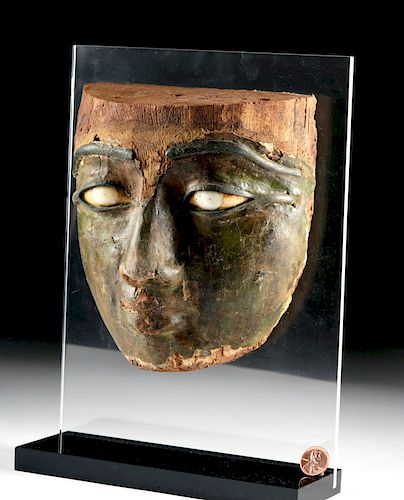Egyptian Stuccoed Mask -Stone Eyes, Bronze Brows & Lids
Lot 4d
About Seller
Artemis Gallery
686 S Taylor Ave, Ste 106
Louisville, CO 80027
United States
Selling antiquities, ancient and ethnographic art online since 1993, Artemis Gallery specializes in Classical Antiquities (Egyptian, Greek, Roman, Near Eastern), Asian, Pre-Columbian, African / Tribal / Oceanographic art. Our extensive inventory includes pottery, stone, metal, wood, glass and textil...Read more
Estimate:
$4,000 - $6,000
Absentee vs Live bid
Two ways to bid:
- Leave a max absentee bid and the platform will bid on your behalf up to your maximum bid during the live auction.
- Bid live during the auction and your bids will be submitted real-time to the auctioneer.
Bid Increments
| Price | Bid Increment |
|---|---|
| $0 | $25 |
| $300 | $50 |
| $1,000 | $100 |
| $2,000 | $250 |
| $5,000 | $500 |
| $10,000 | $1,000 |
| $20,000 | $2,500 |
| $50,000 | $5,000 |
| $100,000 | $10,000 |
| $200,000 | $20,000 |
About Auction
By Artemis Gallery
Feb 21, 2019
Set Reminder
2019-02-21 10:00:00
2019-02-21 10:00:00
America/New_York
Bidsquare
Bidsquare : Exceptional Antiquities, Asian, Ethnographic
https://www.bidsquare.com/auctions/artemis-gallery/exceptional-antiquities-asian-ethnographic-3858
An important one-day auction featuring museum-worthy examples of Egyptian, Greek, Roman, Etruscan, Near Eastern, Far East / Asian, Pre-Columbian, African / Tribal, Oceanic, Native American, Spanish Colonial, Russian, Fossils, Ancient Jewelry, Fine Art, so much more! Artemis Gallery info@artemisgallery.com
An important one-day auction featuring museum-worthy examples of Egyptian, Greek, Roman, Etruscan, Near Eastern, Far East / Asian, Pre-Columbian, African / Tribal, Oceanic, Native American, Spanish Colonial, Russian, Fossils, Ancient Jewelry, Fine Art, so much more! Artemis Gallery info@artemisgallery.com
- Lot Description
Egyptian, Saite Period, 26th Dynasty, ca. 664 to 525 BCE. A dramatic sarcophagus mask carved from cedar (or possibly sycamore) wood and presenting a mesmerizing visage comprised of bewitching stone eye inlays - with the irises delineated in a whiter color (possibly once painted with a vegetable-derived pigment) and the sclera more golden - bronze inlaid eyebrows and eyeliners that have oxidized to beautiful blue-green hues, full closed lips, a straight noble nose, and elegant contours, all on a painted gesso (cartonnage that employs plaster and linen over wood) face of sage green hues perhaps intended to represent bronze. Finely carved and skillfully decorated with pigmented gesso as well as bronze and stone inlays - a very special example. Size: 6.25" W x 7.25" H (15.9 cm x 18.4 cm); 10.625" H (27 cm) on included custom stand.
Ancient Egyptians believed it was of the utmost importance to preserve a body of the deceased, because the soul needed a place to reside after the death. Preservation of the body was done via mummification - a process involving the removal of internal organs that were placed in canopic jars, wrapping body in linen, and then embalming. Death masks like this example were created so that the soul could recognize the body and return to it. For this reason, death masks were made in the likeness of the deceased. Artisans used different materials. Earlier masks were carved from wood. Later, cartonnage, a material made from papyrus or linen and soaked in plaster which was then applied to a wooden mold, was used. Royal death masks, perhaps the most famous being that of Tutankhamen, were made from precious metals. All death masks were intended to resemble the deceased subject; however, eyes were always slightly enlarged and lips presented in a subtle smile as we see in this example.
Masks were traditionally carved from cedar. Interestingly, cedar wood was not native to Egypt. Egypt did not have verdant forests filled with tall trees, and unfortunately most of its native lumber was of relatively poor quality. So they relied on importing to acquire hardwoods - ebony imported from Africa, cedar and pine from Lebanon. One fabulous obelisk inscription by Thutmose III attests to the luxury of treasured hardwoods. It reads as follows, "They brought to me the choicest products . . . consisting of cedar, juniper and of meru wood . . . all the good sweet woods of God's Land." (Obelisk inscription by Thutmose III - J. H. Breasted, Ancient Records of Egypt, Part Two, p. 321)
Provenance: private East Coast, USA collection; ex-collection of Louis & Genevieve Rodis, France, acquired in early 1960s
All items legal to buy/sell under U.S. Statute covering cultural patrimony Code 2600, CHAPTER 14, and are guaranteed to be as described or your money back.
A Certificate of Authenticity will accompany all winning bids.
We ship worldwide and handle all shipping in-house for your convenience.
#143892Overall excellent with some minor consolidation. Expected surface wear commensurate with age with losses to gesso on upper section of head, nose, lips, chin, and peripheries and age cracks and losses to areas of the wood as shown - but overall the surface is strong and stable. Still much of the painted gesso detailing remains as do sections of dowels in drilled hoes for former attachment to mummy. Stone and bronze inlays are in nice condition. Bronze has developed an attractive blue-green patina over the ages. Areas of mineral deposits on visage as well. Collection numbers in black on the verso. Attached to lucite stand with a single screw to the back center.Condition
- Shipping Info
-
All shipping is handled in-house for your convenience. Your invoice from Artemis Gallery will include shipping calculation instructions. If in doubt, please inquire BEFORE bidding for estimated shipping costs for individual items.
-
- Buyer's Premium



 EUR
EUR CAD
CAD AUD
AUD GBP
GBP MXN
MXN HKD
HKD CNY
CNY MYR
MYR SEK
SEK SGD
SGD CHF
CHF THB
THB














